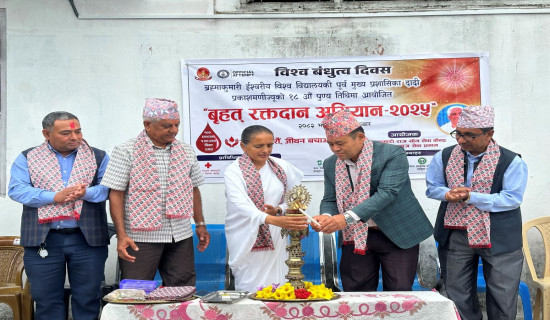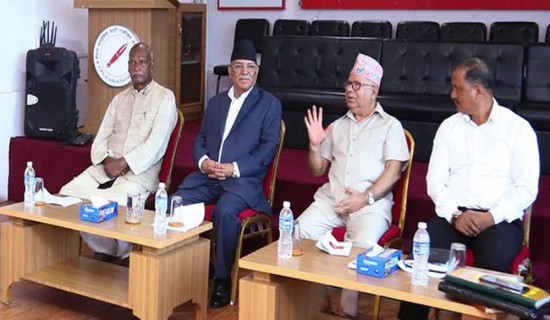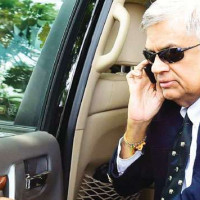- Saturday, 23 August 2025
Enforcing Embossed Numbers Difficult
The government has recently decided to have embossed number plates (ENPs) installed on all vehicles in all provinces, effective from Aswin 2082. According to the decision, in the first phase, ENPs will be mandatory for vehicle registration, ownership transfer, and renewal. For the effective implementation of this provision, transport management offices will provide technical support and traffic police will be mobilised all over the country. The Traffic Police Office will monitor the situation and take action on those vehicles that have not been fitted with ENPs. There is a plan to install ENPs on all vehicles gradually.
The government has been trying to replace manual registration plates with ENPs for the last nine years. On May 30, 2016, the Department of Transport Management (DoTM) and Decatur Tiger IT of Bangladesh inked an agreement for the installation of ENPs on 2.5 million vehicles at a total cost of USD 48.7 million within five years. The DoTM made such a crucial decision when there were not adequate preparations for the ENPs to work: necessary technology and equipment for the use of ENPs, data centres, control rooms, radio frequency identification device (RFID) stickers, towers, readers, satellite connection and the like. This engendered controversy over the decision of the government.
Notice
On November 8, 2021, the Ministry of Physical Infrastructure and Transport published a notice in the Nepal Gazette, requiring the installation of ENPs on new vehicles registered from November 11, 2021. As per the provision, in the first phase, ENPs would have to be installed on public, tourist, private, government and institution vehicles in Bagmati, Gandaki, Lumbini, Karnali and Sudurpaschim provinces. This provision could not be effectively implemented. The DoTM then published a notice urging the installation of ENPs on vehicles from May 15, 2022. This notice also went unnoticed.
In fact, the progress in the installation of ENPs is dead slow. Over the last nine years, less than 100,000 vehicles have been equipped with ENPs. The number of vehicles registered in Nepal had reached 5.3 million by 2024. During the last four years (2021-2024), around 1.63 million new vehicles were registered. The policy of the government on the installation of ENPs is that new vehicles are not allowed to directly have ENPs. First, they are given province-based number plates. After that, the owners concerned have to apply for ENPs online and get them installed on their vehicles after undergoing necessary procedures, including biometrics. When province-based number plates have been installed on their vehicles, most of the owners do not want to go for ENPs. This is one of the major flaws of the policy that have made the progress in the installation of ENPs too slow.
Regarding existing vehicles, the owners have to clear the dues of the fiscal year concerned, even if tax payment or bill book renewal dates are not due. This provision has also made the vehicle owners hesitant to have ENPs installed on their vehicles. If the new vehicles had been equipped with ENPs, the number of ENP-fitted vehicles would have greatly increased. A relaxed policy allowing the installation of ENPs on vehicles regardless of whether revenue by way of annual tax and bill book renewal has been collected would have further increased the number of ENP-fitted vehicles. But the government is not ready to admit such flaws in the policy. Rather, a notice has been issued to implement the ENP provision from Aswin 2082.
The provision of ENPs is not bad per se. This provision is in place in many countries around the world. Our neighbouring countries, India and China have this provision. ENPs have a special type of security number equipped with GPS. Vehicles fitted with ENPs are prevented from theft. Crimes committed using ENP-fitted vehicles can be effectively investigated based on their number plates and RFID gates. The condition of such vehicles can be easily identified and regulated. Vehicle record systems can be made robust through the use of RFIDs. Changing number plates for illegal activities can be prevented. Moreover, fraudulent entry of vehicles can be prevented.
Despite the ENP system being tech-friendly and the need of the hour, the people have not shown interest in the system. In the first place, the people are not happy with the DoTM and transport management offices regarding the problem with the issue of smart licences. It takes over two years to lay your hands on your licence, new or renewed. In the past, when there was the manual system of issuing licences, it took just a week or so. The printing of smart licences is not going smoothly due to a lack of sufficient printers and because of frequent breakdowns of printers. Further, traffic cops have no readers to check smart licences.
Complaints
Amid frequent hassles and complaints from the people, the government has extended the validity of smart licences from five to 10 years. The effectiveness of this provision will not, however, be felt immediately; it will be seen only after 5 years. The government has not constructed all the necessary infrastructure. The government has claimed that it is building necessary infrastructure, such as RFID gates for the inspection and monitoring of vehicles. Till now, only two RFID gates, one at Nagdhunga and the other in Nagarjun Municipality, have been constructed.
An additional two gates are under construction at Pathlaiya and Pharping. When the government is not fully prepared for the management of ENP-fitted vehicles, it would not be prudent to forcibly urge the vehicle owners to have ENPs installed on their vehicles at short notice. The agreement on ENP installation has been extended for two years to November 26, 2025. This must have impelled the government to make the installation of ENPs mandatory from Aswin 2082. However, installing ENPs on over 5.3 million vehicles is a formidable challenge.
(Maharjan has been regularly writing on contemporary issues for this daily since 2000.)

















